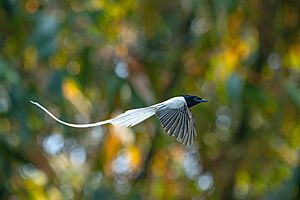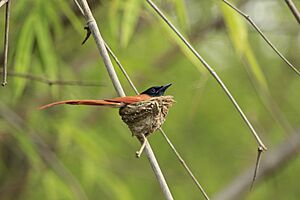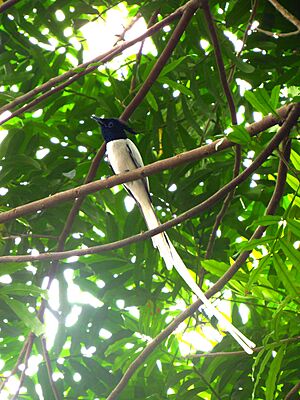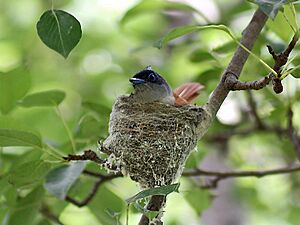Indian paradise flycatcher facts for kids
Quick facts for kids Indian paradise flycatcher |
|
|---|---|
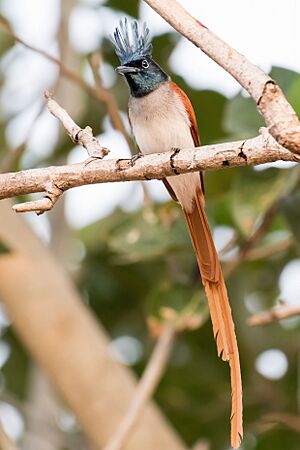 |
|
| Adult male | |
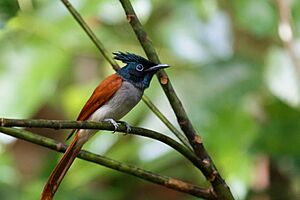 |
|
| Female | |
| Conservation status | |
| Scientific classification | |
| Genus: |
Terpsiphone
|
| Species: |
paradisi
|
| Subspecies | |
|
See text |
|
| Synonyms | |
|
|
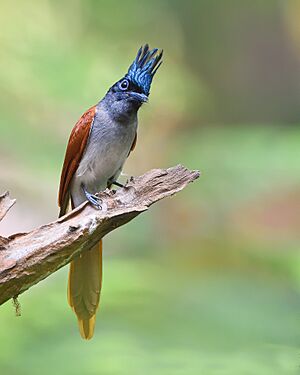
The Indian paradise flycatcher (Terpsiphone paradisi) is a beautiful bird found across Asia. It's a medium-sized passerine bird, which means it's part of a large group of birds that perch. Its population is doing well, so it's listed as 'Least Concern' by the IUCN Red List. You can find it in places like the Indian subcontinent, Central Asia, and Myanmar.
Male paradise flycatchers are quite striking! They have very long tail feathers. Some males are black and reddish-brown, while others are mostly white. Females have shorter tails, reddish-brown wings, and a black head. These birds love to eat insects, catching them right out of the air, often under shady trees.
Contents
Bird Families and Names
Scientists give every animal a special scientific name. The Indian paradise flycatcher was first named Corvus paradisi by a famous scientist named Linnaeus in 1758.
Paradise flycatchers used to be grouped with the Old World flycatcher family. But now, they are part of the Monarchidae family. This family also includes monarch flycatchers.
Until 2015, the Indian paradise flycatcher was thought to be the same species as two others: Blyth's paradise flycatcher and the Amur paradise flycatcher. Together, they were called the Asian paradise flycatcher. Now, scientists know they are different species.
Types of Indian Paradise Flycatchers

Linnaeus first thought this bird only lived in India. Later, people found it in other places. Scientists then described different types, called subspecies, based on how the males looked. Today, three main subspecies are known:
- T. p. paradisi: This type breeds in central and southern India, central Bangladesh, and southwestern Myanmar. Some populations fly to Sri Lanka for the winter.
- Himalayan paradise flycatcher (T. p. leucogaster): This type breeds in places like Afghanistan, northern Pakistan, and parts of India and Nepal. In spring, some populations move to the foothills of the Himalayas to breed.
- Ceylon paradise flycatcher (T. p. ceylonensis): This type lives in Sri Lanka.
What They Look Like
Adult Indian paradise flycatchers are about 19 to 22 centimeters (7.5 to 8.7 inches) long. Their heads are shiny black, with a black crown and a small crest. They have a round, strong black beak and black eyes.
Female birds have reddish-brown backs. Their throats and undersides are greyish. Their wings are about 86 to 92 millimeters (3.4 to 3.6 inches) long.
Young males look a lot like females. They have a black throat and blue rings around their eyes. As they grow up, their two central tail feathers become very long, sometimes up to 30 centimeters (12 inches) long! These long feathers look like streamers.
Young males have short tails and are reddish-brown. They get their long tails when they are two or three years old. Adult males can be mostly bright reddish-brown or mostly white. Some birds have a mix of both colors.
Where They Live and Travel
The Indian paradise flycatcher is a migratory bird. This means it travels long distances. It spends the winter months in warm, tropical parts of Asia. In southern India and Sri Lanka, you can find both birds that live there all year and birds that visit for the winter.
Life Cycle and Behavior
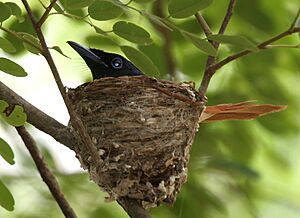
The breeding season for the Indian paradise flycatcher is from May to July. Both the male and female birds work together. They build the nest, take turns sitting on the eggs (incubation), keep the young warm (brooding), and feed their chicks.
The eggs hatch in about 14 to 16 days. The young birds stay in the nest for 9 to 12 days. Sometimes, they build their nests close to drongo birds. Drongos are known to chase away predators, which helps keep the flycatcher's nest safe.
The female bird lays up to four eggs. She builds a neat cup-shaped nest using twigs and spider webs. The nest is usually at the end of a low branch. There has even been a case where Indian white-eye birds were seen feeding paradise flycatcher chicks!
In Culture
This bird is very special in India. It is the state bird of Madhya Pradesh. People there call it Doodhraj.
The Indian paradise flycatcher is also mentioned in some popular detective stories. It appears in Satyajit Ray's Feluda stories, specifically Chinnamastar Abhishap and Jahangirer Swarnamudra.



